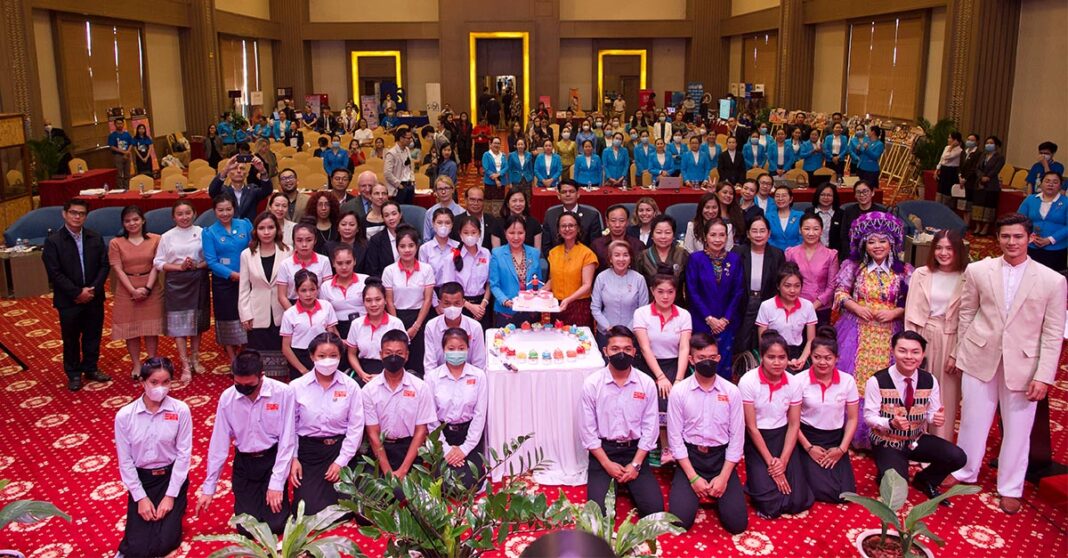On the 10th anniversary of the International Day of the Girl Child (IDGC), the Lao Women’s Union and the United Nations Population Fund (UNFPA), in collaboration with Plan International and partners, celebrated all adolescents in Laos with Noi’s 16th birthday in Vientiane Capital.
Representatives from Government, development partners, international organizations, civil society organizations, the private sector, and young people gathered in Vientiane Capital to celebrate the updates and achievements related to the Noi Framework and Ecosystem for empowering adolescent girls. This celebration also reaffirmed their commitment to being allies and champions for promoting gender equality and empowering adolescent girls.
Speaking at the event, Madame Inlavanh Keobounphanh, President of the Lao Women’s Union, extended her appreciation to all sectors for their investment in giving adolescent girls a chance to be a force for positive change.
“Today’s celebration is very important as it marks the 3rd year of the Noi 2030 Framework implementation. The framework aims to help Lao girls who face challenges in accessing education, reproductive health, sexuality, employment and gender equality, including the opportunity to participate and make decisions in life. This event shows the commitment of the Lao Government, particularly the Lao Women’s Union, UNFPA and partners in indicators of the Sustainable Development Goals, especially the SDG2, SDG3, SDG4, SDG5 and SDG8 that are linked to the Noi framework.”
Investing in girls is investing in our shared future. The theme for this year’s International Day of the Girl Child is “Our time is Now – our rights, our future”, which highlights the importance of working together to ensure that girls enjoy and exercise their rights and can play a full and equal part in their communities and societies.
Ms Mariam A. Khan, UNFPA Country Representative for Lao PDR, said, “More than 600 million adolescent girls globally and over 700,000 in Lao PDR have hopes and dreams to realize. Immediate investments in girls’ rights can remove challenges that block fulfilment of girls’ potential and thereby communities and society’s progress.”
COVID-19 has worsened existing burdens on adolescent girls and increased the challenges to their education, their physical and mental well-being and the protection needed for a life without violence.
“Adolescent girls have shown that given the skills and the opportunities, they can be the change makers driving progress in their communities, building back better for themselves, for women, boys and men. At this time in Laos’s demographic transition, for Laos’ economic recovery, urgent investments are required for strengthening agency and leadership of adolescents,” Ms Khan added.
According to Plan International’s State of the World’s Girls Report 2022, Ms. Carol Mortensen, the Country Director of Plan International Laos, said that “in Laos, as globally, girls are not a homogenous group. Their opinions and experiences are as diverse as they are. They vary as individuals according to location, ethnicity, religion, sexual identity and sexual orientation, and a host of other intersecting factors.
The overarching aim of this research is to explore and understand girls’ and young women’s attitudes towards, and experiences of, political and civic participation and institutions, across these many different backgrounds, looking both at where they differ and at what they have in common.”
Young people celebrated the occasion in the afternoon with panel discussion, informative talks and cultural performances highlighting the issues, aspirations and creativity of the young generation.
Ms Sousananh, a 17-year-old schoolgirl from Bokeo Province – the head of the debate champion team – shared that “The International Day Girl Child event is meaningful to adolescent girls. This year was extraordinary for my friends and me because we could express our thoughts and ideas about our rights and bodies through the debating competition in Houayxay District Bokeo Province. It was a wonderful moment when people listened to our voices.”



